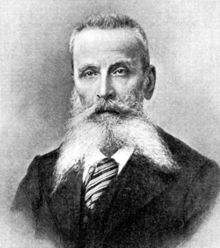Ernest Gibert
Ernest Ivanovich Gibert ( Russian Эрнест Иванович Жибер * 25. December 1823 in Paris ; † February 4 . Jul / 17th February 1909 greg. In St. Petersburg ) was a French - Russian architect and university lecturer .
Life
In 1833 Gibert's father entered Russian service and settled with his family in St. Petersburg. Gibert began studying at the Imperial Academy of Arts in 1842 with Karl Pawlowitsch Brjullow . He completed his studies in 1849 as an artist first class with a gold medal with a project to build a stock exchange .
In 1849 Gibert became senior assistant to the architect Roman Ivanovich Kuzmin in the renovation of the Gatchina Castle and the construction of the St. Paul's Cathedral in the neo-Russian style (1846-1852) in Gatchina . In July 1852 Gibert became a drawing room architect of the project and finance department of the main administration for traffic routes and public buildings with the rank of titular councilor (9th class ). In October 1852, after the completion of the work in Gatchina, he received the Order of St. Anne III. Class and an annual salary of 750 silver rubles . He built two churches (1848–1849 and 1855–1856) in St. Petersburg's Novodevichy Convent, which have not been preserved. In 1857 he and Karl Jakowlewitsch Majewski built two imperial barracks on Riga Prospect in St. Petersburg.
In 1858 Gibert began to teach at the St. Petersburg Building School, later the Institute for Civil Engineers (until 1903). In 1859 he was appointed professor of architecture for his project to build the Academy of Medicine and Surgery . He became a member of the building committees of the interior ministry and the imperial court. Gibert was interested in the Old Russian and Byzantine architecture and traveled a lot. He designed the interiors of the Anitschkow Palace (1865–1867). In Samara he built the Cathedral of Christ the Savior (1869-1894), which was demolished in the winter of 1932 (after being converted into a clubhouse in 1930). In Zhytomyr he built the Savior and Transfiguration Cathedral (1866–1874) with Karl Karlowitsch Rachau and WG Schalamow , in which specialists from the previous construction of St. Petersburg 's St. Isaac's Cathedral were also involved. Other churches were built in Mogilev , Tarashcha and Perejaslav . In St. Petersburg he built building complexes for the chemical laboratory and for the state paper warehouse. In Vienna he visited the World Exhibition in 1873 . Based on a model by the sculptor Nicolas-François Gillet from 1760, he created a monument to Peter I in front of Peter I's house in St. Petersburg in 1875 .
From 1879 to 1887 Gibert was the chief architect of the Office for Social Services of Empress Maria . In 1880 he and Gawriil Wassiljewitsch Baranowski built a workshop building for the Baltic Shipyard and in 1881 in St. Petersburg a three-story house with side wings for Joseph Frédéric Dutfoy. For the Tomsk State University he worked out a project that was not implemented due to excessive costs.
In 1883 Gibert became chairman of the St. Petersburg Society of Architects. He was also the editor of the Russian architecture magazine Sodtschi . In 1896 he received the Alexander Nevsky Order . In 1897 he became an honorary member of the Academy of Arts. In 1897 he and GF Schreiber built the Lutheran Church of St. Mary in Yalta .
Gibert was married to Olga Fegin (1838-1900), with whom he had three sons and a daughter. The eldest son Georgi-Henrich-Vladimir Ernestovich became a military engineer in the Russian army and took part in the White Movement after the October Revolution . Yevgeny Ernestowitsch was a civil engineer and lawyer and married the poet Marija Alexandrovna Lochwitskaja . The youngest son, Alexander Ernestowitsch, was a traffic engineer and designed, among other things, the railway bridge in Riga .
Gibert was buried in the Lutheran part of the Smolensk Cemetery in St. Petersburg.
Individual evidence
- ↑ Некролог Э. И. Ибера . In: Зодчий . No. 30 , 1909, pp. 335 .
- ↑ Эрнест Иванович Жибер (по поводу 50-летия его служебной деятельности) . In: Зодчий . No. 30 , 1902, pp. 335336 ( nlr.ru [accessed March 30, 2018]).
- ↑ a b c d e Александр Берташ: ЖИБЕР . In: Pravoslavnaya Enziklopedija . tape XIX , 2008, p. 164–166 ( pravenc.ru [accessed March 30, 2018]).
- ↑ Справочник Научных Обществ России: [ЖИБЕР Эрнест Иванови] (accessed March 30, 2018).
- ↑ Петрова О. В .: Альбом чертежей и рисунков архитектора Э. И. Жибера из собрания Гатчинского дворца (accessed March 30, 2018).
- ↑ a b Борис Дубман: Выдающиеся архитекторы прошлого в истории Житомира (accessed March 30, 2018).
- ↑ Залесов, Валерий Геннадьевич: Архитекторы Томска (XIX– начало XX века) . Издательство Томского государственного архитектурно-строительного университета, Tomsk 2004 ( tomsk.ru [accessed March 30, 2018]).
| personal data | |
|---|---|
| SURNAME | Gibert, Ernest |
| ALTERNATIVE NAMES | Жибер, Эрнест Иванович (Russian) |
| BRIEF DESCRIPTION | Russian architect and university professor |
| DATE OF BIRTH | December 25, 1823 |
| PLACE OF BIRTH | Paris |
| DATE OF DEATH | February 17, 1909 |
| Place of death | St. Petersburg |


